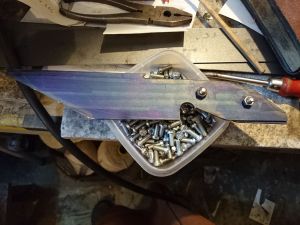Well, my latest resin project didn’t go that well. I wanted to created little snowglobes using wooden deco elements. The idea was to pour the lower half of the moulds, wait some time until the pot time is over, push the elements into the resin, let cure, add the top half, add a wooden base, be happy.
As you can imagine, reality had other plans. First of all the resin was still too soft to hold up the deco elements. The right moment would probably have been 5 minutes in the middle of the night.
I tried to stabilize them with bamboo skewers, but it was less than optimal.
The next day I added the top half. The hole is pretty small so I needed a syringe to put in the resin. Usually the two half separated a few times during the process and were a pain to put together again.
First of all, that introduced way too much air, second of all, I added too much glitter.
The results are sad. Very sad.
But I’m not giving up just yet. For the next trial I’ll do the following: I’ll cut off part of the top half so I get a bigger opening. I will then glue the halves together so they won’t separate. And I already glued the deco to the wooden platforms. I’ll pour the globes in one go (with less glitter) and then push in the elements and just let the base close the mould.
But in the meantime I had fun with the kids and my friends and we made many nice things.
My favourite one is the under water scenery, which I promptly turned into a necklace:
The plants are some fern which I collected and dried last week.


























